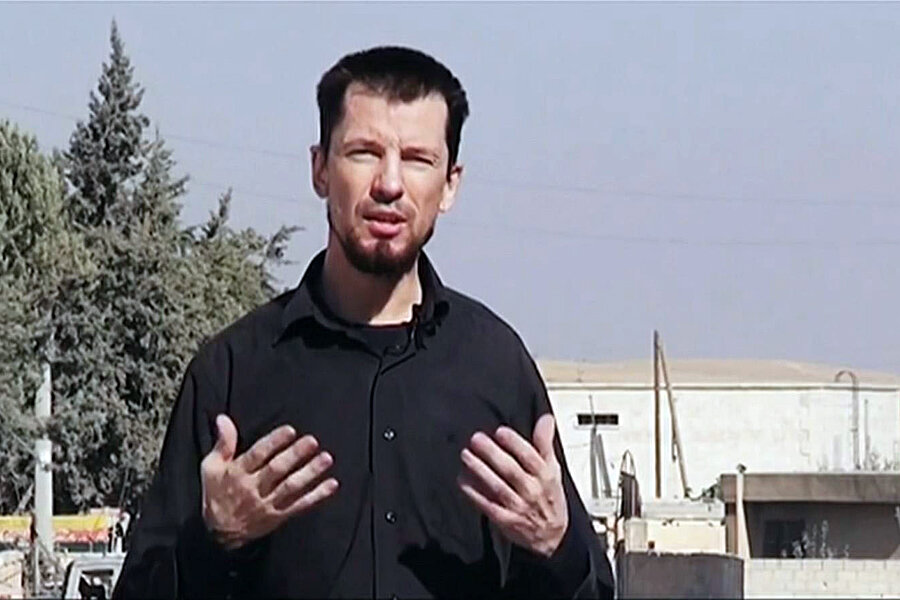Captive John Cantlie is a propaganda prop for Islamic State
Loading...
With its first video of John Cantlie, a British reporter held captive by the so-called Islamic State, the group signaled its intent to use him for a different kind of propaganda than its typical snuff videos.
Mr. Cantlie, kidnapped a little less than two years ago, was forced last month to read a script outlining the group's views and urging the US and UK to pay ransom to the group. Subsequent videos, entitled "Lend Me Your Ears" and seemingly shot indoors, followed a similar pattern. But the group promised more from their captive, and delivered yesterday with what's presented as a dispatch from the Syrian-Kurdish town of Kobane, just across the Turkish border.
The group's effort to overrun Kobane has stalled in recent weeks, thanks in part to US and UK airstrikes and drops of weapons and ammunition to its Kurdish defenders. Today, about 150 Iraqi Kurdish fighters were reported to be transiting through Turkey to join the fight. The Kurdish Iraqi fighters also appear to be bringing some heavier artillery.
Should IS capture Kobane, it would gain control of even larger stretches of the Syrian border with Turkey, as well as a powerful propaganda victory in showing its defiance of Western powers. The group also appears to believe its propaganda can weaken the US-led coalition's support for Kobane's defenders.
Cantlie's script is filled with sarcasm and taunting. He points out that there are no Western reporters in Kobane, implying cowardice or a cover-up. Of course, the men writing his scripts despise a free press. His captivity, and the filmed beheading of journalist hostages like James Foley, who was kidnapped along with Cantlie, are evidence of that, as are the dozens of Iraqi and Syrian journalists killed by the group over the years.
The video, judging by references to reported events, was likely filmed within the last week. Cantlie refers to the cost of airstrikes around Kobane as being "almost half a billion dollars" (the running cost of the broader effort in Iraq and Syria was placed at $424 million by the Pentagon on Oct. 21), and to two bundles of airdropped supplies to defenders that missed their targets and ended up with IS, which was first reported that same day.
Even if the Islamic State didn't have a well-deserved reputation for lying, its propaganda video would still be useless as any kind of guide on the ongoing battle for Kobane. Cantlie's script refers to "mopping up" operations and the battle for the town being "nearly over." The reality is clearly more complex.The town is about half controlled by IS, and half by its Kurdish defenders, a situation that has persisted for weeks.
Not that IS will care, but using captives as a propaganda prop – terrorized by the murder of fellow captives and the threat to their own lives – is a clear violation of the Geneva Conventions.
To be sure, this crime seems minor when held up against their executions of helpless captives, enslaving of women and children for sexual and other purposes, and their stated goal of wiping out everyone on the planet who doesn't practice their particular version of Islam. But the press needs to walk a careful line in not uncritically broadcasting the group's propaganda, effectively rewarding them for their abuse of Cantlie.
Still, such propaganda from a group that revels in its own barbarism isn't going to wash away a legacy of beheading aid workers and journalists, gunning down hundreds of captured soldiers, or laying waste to whole towns. Could the group be unhappy with its bad press? Well, the murder and torture of civilians and journalists tends to do that. Mr. Foley was repeatedly subjected to the torture known as waterboarding, chained upside down and suspended by his ankles from an iron bar, and forced to undergo mock executions before his murder, according to New York Times interviews with former hostages held with him. Cantlie and other captives faced the same treatment.
As an exercise of projecting control, high-profile videos of Cantlie are probably useful in firing up the small numbers of Muslims around the world who applaud the group's mayhem and vows to remake the world on the back of a river of blood. For everyone else, it's a small, pointed reminder of the group's viciousness.








